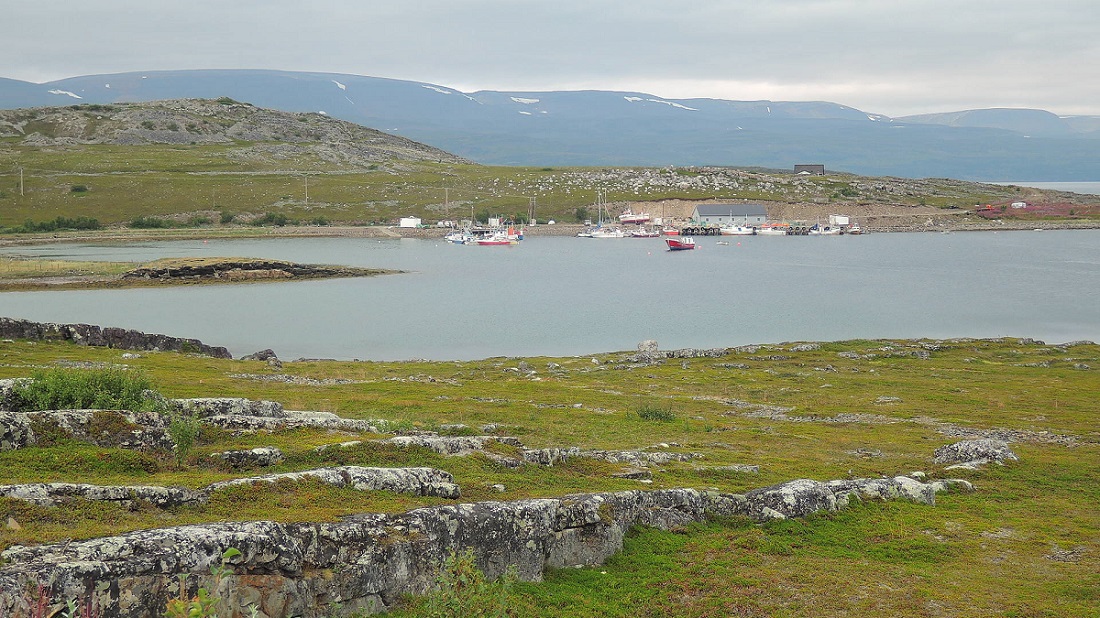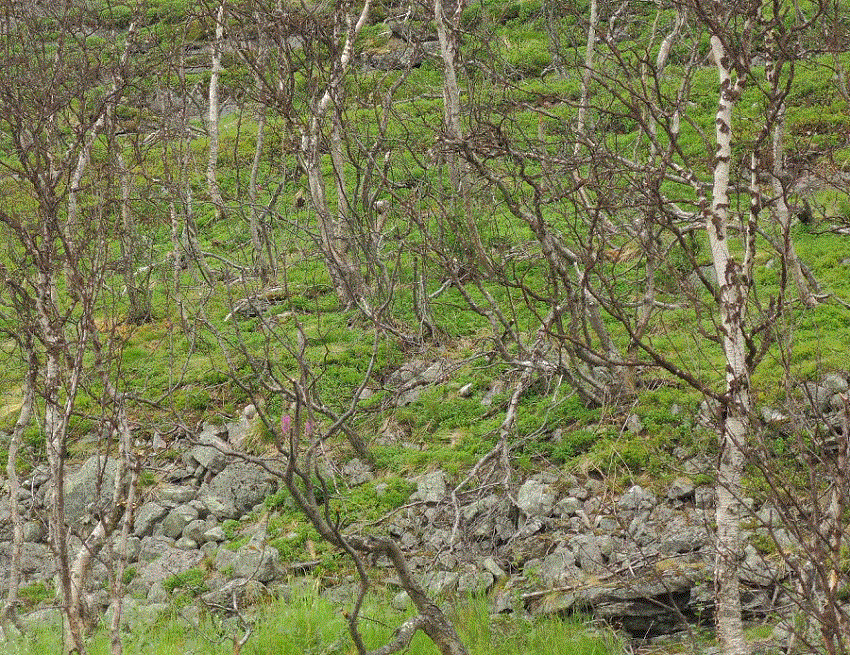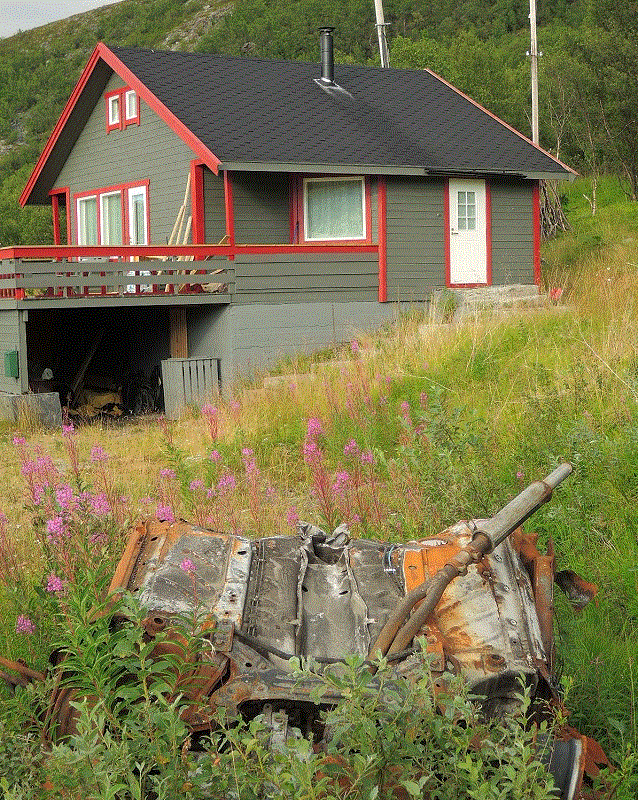The rover who roams towards Nowhere does not want to retrace his steps or tread twice the same path. Why should he go past again places where his unknown destination–if at all exists!–was not already found? The search must go on somewhere ahead, not back. So, despite myself, today I will ride back the road–for the first time this trip; and not last, I foresee: there are in this country many villages where the only way out is the same way in. By the way, this kind of places were called terminal towns by Spanish philosoper Miguel de Unamuno, who attributed to them a stronger character than average. Well, I do not know that much, but how could one deny that such isolated populations, not being in the way of anywhere else, and being therefore less influenced by the contact with social diversity, preserve their own idiosincrasy longer?
Thus, my visit to Vadso means I have to drive back fifty kilometres, as further on there is only Vardo, Norway’s easternmost tip, a balcony over an earlier time zone and the ocean. It’s a bit dizzy to think that Vardo is more to the east than St. Petersburg.
This second time in Varangerbotn crossing, I take a break for a soup in Varangerkroa. Soup of the day is one of the brightest sides of Scandinavian eating habits: as far as I know, from Iceland to Finland, there is no restaurant, self-service, cafeteria or fast-food not offering your typical thermal pot–lid and ladle–full of hot, tasty and nourishing soup, the kind that brings back the dead.
From Varangerbotn, fifteen kilometres of stony tundra over the hills to the west there is Tana Bru; a nice sonorous name for a service town and meeting point of two Lappish routes. It is a lively one this Bridge over Tana river–such means its name. Several petrol stations, supermarkets, workshops, restaurants and hotels for the needs of the tourists driving east or west. I seize the opportunity for fueling up, because Rosaura’s tank is half empty and ahead of us there lie a long stretch of uninhabited land except for two or three farms and summer cottages.
Finnmark’s orography is bizarre, and it doesn’t like roads–judging from the twisted route. In some areas there is taiga, but tundra prevails, and these stony hills over the barren highlands full of boulders remind me of Iceland a lot: the bare peaks, the featureless slopes by the seaside, covered at best by low vegetation struggling for life among the rocks. The pavement of this solitary road that cuts across Nordkinn peninsula is quite rough, wrinkled, patched and potholed. On the other hand, nature and the ecosystem are preserved wild, unaltered. There is pleny and diversity of birds all over, as well as reindeer and other fauna, and the native vegetation lives here unmolested, pure, free from men’s intrusion. A fussy friend of mine from the States loves to mock at forests “in Europe” (typical mistake, equating a huge but homogeneous nation with a small but heterogenous continent) saying they are replanted, but obviously he has never seen Norway. Ignorance is usually outspoken.
This stage’s last winding and craggy fifty kilometres cover Nordkinn’s arid highlands between Tana and Laksen fiords. Though slow, this stretch makes for a fun and astounding bike ride: along these bare tops at the mercy of wind, there’s nothing but rock, grass and ponds; small pools whose water lives there all year round because the ground does not drain the thaw. And you meet not a soul on the road. Only the cold wind makes Rosaura and me company.
Eventually we arrive to Ifjord on the west side, a “locality” consisting of just one building featuring a restaurant, motel, campsite and petrol station. On the steps to the main door there sits a fat man, quite disheveled, who does not answer my hello. Inside there is a large unobstructed room with a few tables, a pool, a small counter with the till, a fruit machine, an icecream freezer and a display cabinet with some useful things for sale; no souvenirs, which is a plus. The large set of windows facing sunset show a panoramic view to the tundra, and when the sun comes out from behind the clouds, the light pours in through the panes, merrily shining onto the red and white squares of the mantlecloths.
The man in charge is a terse yet kind fellow of slow motion and words, the kind who seem to always keep in mind: a day at a time; no hurry. Though actually, living in this corner of the country, where would he go to? I ask for acommodation and get the key to a hut in the campground, by the creek, and another to a room downstairs. The view is equally fine from both: facing the forest and a creek where the sun glimmers with a thousand shines. I take the room and park Rosaura in the back, below my window, then bring my things in. When I come back, the fat guy on the steps speaks to me, as if carrying on some previous conversation. I sit by and chat for a while, like if we were acquainted good neighbours. He turns out to be a very fine fellow.
As I want to profit this warm evening sun, I go for a stroll. Right in front of the pumps, across the road, a faded path on bright green grass goes up the hill, advancing towards the grove and disappearing among the white tree trunks. Thus lit up, the grove makes a beautiful contrast with the violet clouds towering above on the eastern sky. It is irresistibly inviting.
How wild is all this! Once I get deep the little forest I run into a herd of grazing reindeer who don’t care much for my presence. When I get too close, they dash off a few leaps and keep minding their own business. After a while, the path vanishes and the ground gets bushy and muddy, oozy, wetting my tennis shoes, so I go back down, then walk along the road for a while.
And how cool summer cottages these Norges own, good for a contest!: neat, well painted, better furbished, stylish, finely ornated and excellently located, always on the best spots–though, well, there aren’t many ugly spots in Norway, you know.
But despite the education we presuppose to Norwegians, I’m afraid they’re not so respectful with the environment: while walking along the shore of Laksefjorden I run into a fair amount of litter; not the kind of waste a tourist makes, but household litter: plastics, oil drums, soap drums, iron parts and the like. Then, right on the ditch by a cottage lot, there lives the junk of a car, underside looking up. It is squashed, partly hidden by the weed, its rusted iron camouflaged with the rock, yet blatantly offending the senses; its undeniable presence denounces that presumedly civilized Norway can also litter badly.
When I come back “home” I find my fat friend sitting at a table, finishing off some greasy dish. Before leaving the place, he wishes me a nice trip; then climbs up a big car and drives away down the road. Now I realize I’m also hungry. I order a beer of suggestive name and out the limited menu I pick some kind of fish’n’chips. A Thai woman serves me. Even here there are immigrants, in uninhabited Ifjord. Norway must be really packed with them.
My last thought for the day goes to back the rubbish I’ve seen on the seashore and the road. I might understand that people in uncultured countries throw their junk to the ditch, but in Norway, littering is an inexcusable sin.






